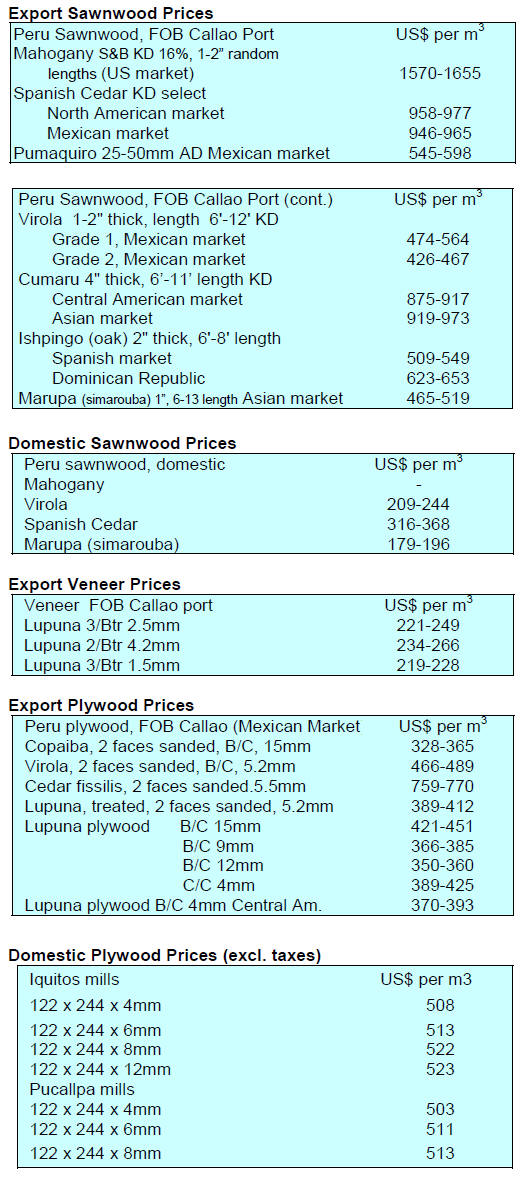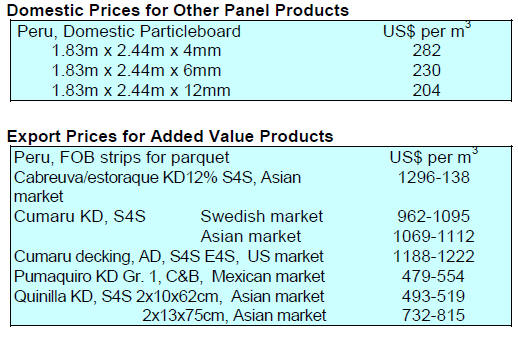2. GHANA
Ghana signs controversial EPA with EU
Ghana is now preparing to bring into law the Interim
Economic Partnership Agreement (EPA) negotiated with
the European Union. The agreement is expected to ensure
that local businesses and industries can export more &Made
in Ghana* goods to the EU market quota and duty free.
However, manufacturers and service providers in the EU
ill enjoy the same benefits for their exports to Ghana. This
EPA was first mooted by Ghana*s former President J. A.
Kuffour back in 2007.
Countries which sign the EPA will benefit from a euro 6.5
million aid package over a five year period to help cushion
the impact of open markets to EU suppliers.
Other West African countries have until 1 October 2016 to
sign the EPA So far 13 of the 16 ECOWAS countries have
signed with the exception of Nigeria, the Gambia and
Mauritania.
In a related development, the Ministry of Trade and
Industry has initiated a four-phase strategy to support local
companies expand exports to the US. This strategy is part
of the US government*s trade initiative with sub-Saharan
African countries &African Growth and Opportunities Act
(AGOA)*.
Ghana Exim Bank open for business
The Ghana Exim (Export-Import) Bank began operations
last year after parliamentary approval of the Ghana
Export-Import Bank bill. The new export promotion bank
is the result of a merger of three agencies, the Export
Trade, Agricultural and Industrial Development Fund the
Exim-guaranty Company Ghana Limited and Export
Finance Company.
The main aims of the new agency are to support and
develop Ghana*s international trade capacity and to
strengthen the competitiveness of Ghanaian companies in
international markets.
In his mid-year review of the 2015 Budget the Finance
Minister said the bank is working to help address the
challenges faced by domestic companies, especially
SMEs, in securing credit.
Exports to regional markets fell in the first quarter
The top export destinations for Ghana*s wood products in
the first quarter of 2016 were China, India, Vietnam,
Germany and Italy which together accounted for just over
68,20,000 cu.m worth euro 38,7 million or 74% and 77%
of total first quarter volume and value exports.
In terms of volume China accounted for 33% while India
imported 32%. Despite the significant expansion of export
to Asian markets trade to regioal markets weakened.
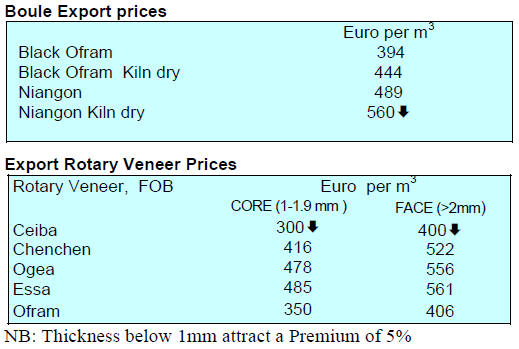
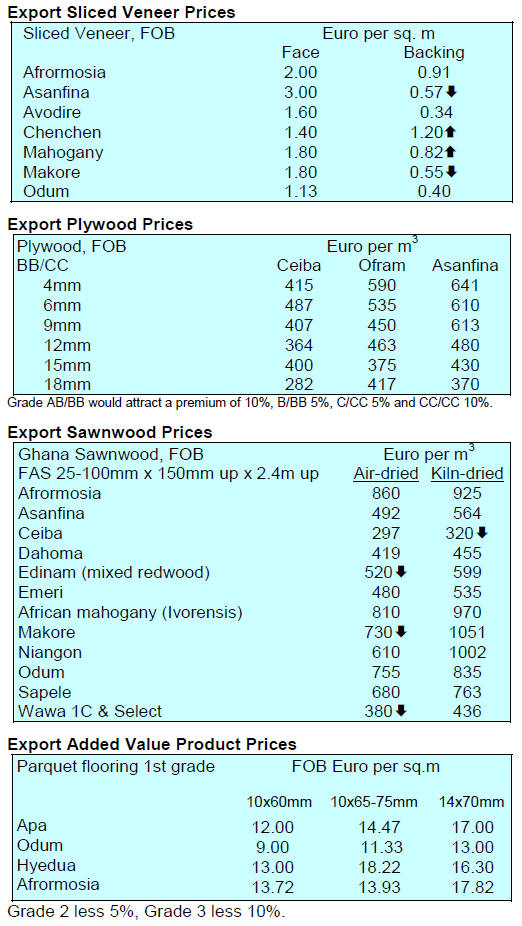
3. MALAYSIA
India, Malaysia*s third largest timber
trading partner
The Malaysian Timber Council (MTC) arranged a
marketing mission to Chennai and Bangalore, India at the
end of August. The delegation was led by MTC Chief
Executive Officer, Datuk Dr Abdul Rahim Nik, and
included 19 Malaysian timber exporters to India.
India was Malaysia*s third largest timber trading partner
after Japan and the United States in 2015. The value of
wood products imported by India from Malaysia amounted
to almost RM1.9 billion in 2015, an increase of 6.3%
compared with 2014.
In the press release on the mission the MTC CEO said
※India holds huge promise as it is ranked as one of the top
three most attractive investment destinations in the world.
Its growing middle class and demand for timber as well as
timber-based products have prompted MTC to open a
regional office in India this year.§
When Myanmar introduced the log export ban in 2014
Indian importers began to import more logs and
sawnwood from Malaysia.
For more see: http://mtc.com.my/wpcontent/
uploads/2016/08/Mission-to-India.pdf
In related news, MTC plans to operationalise its office in
Bangalore in January next year to help strengthen
Malaysia*s marketing in India as well as neighbouring
countries. The MTC office in India is the fourth after those
in the United Kingdom, Dubai and China.
In announcing the new office Malaysia*s Plantation
Industries and Commodities Minister, Datuk Seri Mah
Siew Keong, reported that the MTC office in India will
also promote Malaysian wood products in Pakistan, Sri
Lanka and Bangladesh.
Boost for Johor furniture exporters
Wooden furniture exporters in Johor, a state in southern
Malaysia close to Singapore contributed around 60% to
Malaysia*s total wooden furniture exports in 2015. In
August a 5 year roadmap was launched for the
development of Johor's wood furniture industry.
This sets out ways to sustain the furniture manufacturing
sector given the challenges in international markets and in
addressing the domestic shortage of manpower in the
sector. The roadmap also addresses how to maintain and
improve the competitiveness of the state*s furniture
industry.
Deputy Plantation Industries and Commodities Minister,
Datuk Datu Nasrun Datu Mansur and Malaysian Timber
Industry Board Director-General, Datuk Dr Jalaluddin
Harun reported that land is being acquired in Muar for the
development of a Muar furniture hub and that nearby
Tangkak be developed as a centre for exhibiting wooden
furniture manufactured in the state.
Plywood prices
Plywood Traders in Sarawak reported the following export
prices:
Floor base FB (11.5mm) US$560-570/cu.m FOB
Standard panels
S Korea (9mm and up) US$380/cu.m FOB
Taiwan P.o.C (9mm and up) US$400/cu.m FOB
Hong Kong US$400 FOB/cu.m
Middle East US$400/cu.m FOB
It has been reported in Japan that Sarawak plywood
manufacturers have come together to agree production
cuts in plywood specifications for the Japanese market due
to weak demand.
4. INDONESIA
Indonesia to ship first FLEGT licensed
wood products
in November
In a press release on 18 August the European Commission
announced it is ready to recognise Indonesia*s licensing
scheme for exports of verified legal timber.
The press release says ※One third (by value) of the EU's
tropical timber imports comes from Indonesia and the EU
buys 11% of timber products and paper exported from the
country.
The delegated regulation amends the FLEGT Regulation
to include Indonesia and its Licensing Information Unit
under the list of &Partner countries and their designated
licensing authorities*. It now also includes Indonesian
products covered by the FLEGT licensing scheme in the
list of &Timber products to which the FLEGT licensing
scheme applies only in relation to the corresponding
partner countries*.
The delegated regulation will enter into application on 15
November, making this the earliest date that Indonesia
could begin to issue FLEGT licenses. The EU-Indonesia
Joint Implementation Committee will announce the date
for FLEGT licensing to begin when it meets on 15
September§.
See: http://eur-lex.europa.eu/legalcontent/
EN/TXT/?uri=uriserv:OJ.L_.2016.223.01.0001.01.ENG
&toc=OJ:L:2016:223:TOC
Merger of main furniture and handicraft industry
associations
A new association, the Indonesian Furniture and
Handicraft Industries Affiliation (HIMKI) has been
inaugurated. HIMKI is a merger of the two associations,
AMKRI and Asmindo said HIMKI Chairman, Soenoto.
Since taking office the Indonesian President, who has a
background in the furniture sector, has been encouraging a
merger of the two associations in order to present a united
voice for the industry and to advance the competitiveness
of the sector.
Plan for all-out effort to encourage investment in wood
processing industries
Airlangga Hartanto, the Indonesian Minister of Industry
has said the government has set a target for wood product
exports at US$5 billion in five years. Statistics from the
Ministry of Industry show that the export value of wood
and rattan furniture was US$1.9 billion in 2014 and rose to
US$2 billion in 2015.
To help the private sector achieve the five year target he
indicated that an all-out effort to encourage investment in
the timber, furniture and national craft industries will be
made and that there will be a synergy of policies to realise
the US$5 billion export figure.
In related news Indonesia-investments.com has offered an
analysis of the manufacturing sector in Indonesia and says
if it is to contribute more than the current 20% to GDP it
needs a big boost. Indonesia*s dependence on commodity
exports heightens the risks to the economy.
Data from Indonesia's Industry Ministry reported in
the
analysis show that the domestic industry is growing at a
slower pace than Indonesia's overall economy.
Indonesia*s new Minister of Industry, Airlangga Hartanto,
sid his aim is to boost and strengthen the competitiveness
of Indonesia's small and medium-sized industries so that
they can compete with imported goods.
For more see: http://www.indonesiainvestments.
com/news/todays-headlines/manufacturing-industryindonesia-
in-need-of-development/item7070
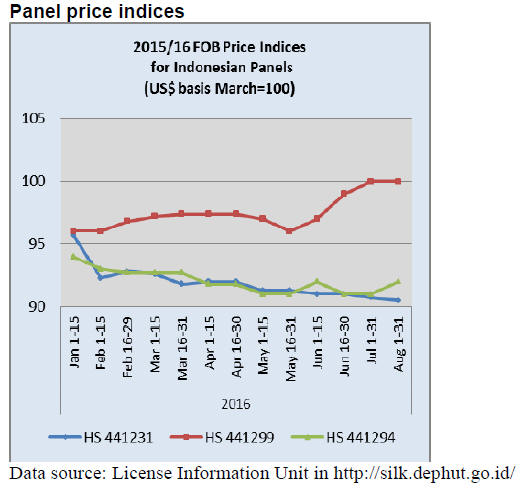
New approach to monitoring SVLK
The Ministry of Environment and Forestry and the
National Accreditation Committee have agreed to jointly
monitor the Independent Assessment and Verification
Organisation which act as the watchdog for the country*s
timber legality assurance system (SLVK).
Ministry of Environment and Forestry Director General
for Sustainable Forest Management, Ida Bagus Putra
Prathama, said this will enhance the commitment and
credibility of the Indonesian timber legality verification
system.
World Islamic Economic Forum nets agreements worth
US$900 million
The recently concluded World Islamic Economic Forum
was a success as a range of agreements were reached for
investment in a wide range of service and industrial
sectors.
This forum brought together government officials,
company executives, academics innovators and investors
from over 70 countries to explore opportunities for
business partnerships in the Muslim World. The theme of
the forum was "Decentralising Growth and Empowering
Future Businesses"
Indonesia Finance Minister Sri Mulyani Indrawati said in
her closing remarks emphasized the crucial role of SMEs
in driving economic growth.
See: http://foundation.wief.org/
5. MYANMAR
Powerful quake strikes near Bagan
A powerful earthquake shook central Myanmar on 28
August. The quake struck near the town of Chauk, on the
Ayeyarwaddy River just south of Bagan.
The 6.8 magnitude quake killed three and damaged many
of the centuries-old Buddhist pagodas around the ancient
capital of Bagan and was felt across the country.
Our sympathy goes out to those affected.
Debate continues on harvesting ban
In a workshop held late July the former Director Genaral
of the Forestry Department, Dr. Kyaw Tint, explained his
latest research on how the Myanmar Selection System
(MSS) could be modified in the light of the decision to
restrict harvesting.
Dr. Kyaw*s conclusion was that a total harvesting ban
could create as many problems for the forestry sector as it
is intended to address and that sustainable harvesting
could be permitted in designated areas under close
monitoring.
In a related development U Myo Min, Director of the
Forestry Department has been quoted as saying the
harvesting contract between the Myanma Timber
Enterprise and private logging companies will be
cancelled.
It has been stated that MTE will undertake all logging with
its own resources when harvesting resumes after the 2016-
17 one year logging ban, However, the industry is asking
what volumes the MTE will be capable of delivering.
The debate on the proposed total harvesting ban rages on.
From the industry*s point of view a total ban will mean
they are starved of raw materials, may have to curtail
production and may have to reduce their workforce.
On the other hand there is an urgent need to get the
country back on the track of sustainable and legal
harvesting and to eliminate the illegal cross border trade.
Myanmar to encourage private plantations but
questions remain on tax relief
The new government in Myanmar is working its way
through the legislation and making changes that will
impact the timber sector.
In answer to a question in parliament Minister Own Win
indicated that in order to increase forest cover the
domestic and foreign private sector is being encouraged to
invest in plantations. It has been reported that 15 investors
have won approval for tree planation development and that
some 30,000 ha. have been established.
In related news, the government has indicated that
overseas investors will no longer automatically benefit
from tax exemption under the new Investment Law. The
previous administration allowed tax exemption for five
years for a wide variety of sectors. For priority sectors the
current law provides for discretion depending on the
industry and size of investment.
Duty free imported raw material 每 old legislation needs
to be addressed
With regard to the decision to allow duty free import of
timber raw materials an American delegation visited
Myanmar to discuss the investment policy and law. The
government decided to allow duty free import of raw
material which will be reprocessed for export.
The discussions revealed that the Union Taxation Law is
still operable and that this imposes a 25% tax on imported
logs and wood raw material. The domestic industry is
urging the government to address this through amending
the old legislation.
Economic policy 每 a focus on national reconciliation
In a statement explaining the government*s economic
policy the emphasis was on &greater fairness* in the
allocation of resources among regions and states that
would underpin the country*s pursuit of national
reconciliation. The aim is to achieve national
reconciliation through the establishment of a strong
market-oriented economic system.
Some of the states and regions that have been neglected in
the past such as Kachin and Shan State as well as the
Sagaing Region produce jade, gold and minerals while oil
and natural gas is found in Rakhine State. However, until
now income from these natural resources has been
accumulated by central government with just a fraction
being returned.
Kachin State Chief Minister U Khat Aung has pointed out
that for decades the returns from timber and jade
production have not benefitted the state. Natural resource
sharing was on the agenda at a recent summit of ethnic
organisations held in Kachin and the gathering called for
greater debate on resource sharing.
The policy statement also touched on foreign investment
reform of state enterprises and support for SMEs. The
government policy aims to encourage responsible
businesses and create an environment where companies
feel secure to invest.
At the same time state enterprises will be made more
accountable and transparent. On SMEs the policy
framework includes efforts aimed at increasing SME
access to financial services and developing a more skilled
workforce.
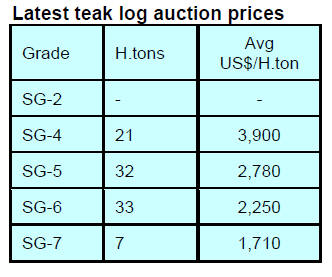
6.
INDIA
Inflation rate trends down
The Office of the Economic Adviser (OEA) to the Indian
government provides trends in the Wholesale Price Index
(WPI).
The official Wholesale Price Index for All Commodities
(Base: 2004-05 = 100) for July was 183.9 up 1% from 182
in June. The year on year annual rate of inflation, based on
monthly WPI, stood at 4.91% (provisional) in July 2016
compared to 1.62% in June.
For more see: http://eaindustry.nic.in/cmonthly.pdf
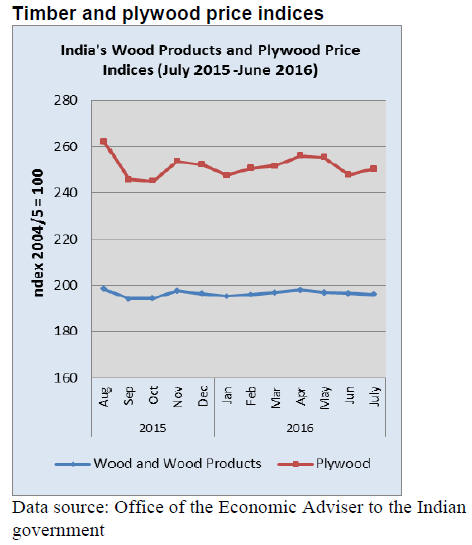
Launch of new ※Housing Data Project§ for the
Indian
housing industry
The Confederation of Real Estate Developers* Association
of India, better known as CREDAI, recently concluded its
16th convention. This year the convention was held in
Shanghai under the theme 每 &Embracing Change*
The aim was to facilitate the exchange of knowledge and
experiences on the global best practices in the industry
against the backdrop of the Indian and Chinese economic
development prospects.
At the convention, CREDAI launched a new tool for
the
sector called the ※Housing Data Project§ this is a maiden
attempt at providing data from which to gain a good realtime
appreciation of India*s housing sector.
The project will provide details of housing stock, project
launches, absorption and the unsold inventory in 12
biggest urban areas in the country. CREDAI & Cushman
Wakefield also launched a joint report on *Embracing
Change: Exploring Growth Markets for Indian
Housing*. The report traces the major factors at work
which determine housing demand and supply in Tier II
and Tier III cities.
See: http://credai.org/press-releases/credai-16th-natcon--
embracing-change-held-in-shanghai-china
ODISHA 每 export promotion targets China
Odisha, (formerly Orissa) is one of India*s 29 states and is
located on the east coast on the Bay of Bengal. The state
has abundant natural resources and a large coastline. The
government of India has selected the coastal region of
Odisha to be developed into one of the Special Economic
Regions in the country.
Odisha is rich in forest resources and the state
administration is encouraging manufacturers of wood
products to export to China. A team from the Odisha
Forest Development Corporation (OFDC) plans to visit
China in September to promote the export of wood
products including sal and asana which is prized wood for
carving.
The OFDC launched an online forest products portal
which attracted buyers from all over India. OFDC, the
state government owned-corporation, earned a record
Rs6.85 billion revenue in 2015-16 and posted a net profit
of Rs 259.20 million.
New MDF plant for Southern India
Greenply Industries Ltd has announced plans to build a
new MDF plant in Chittoor, Andhra Pradesh. The plant
would have an annual production capacity of between
30,000 to 36,000 cubic metres and should be operational
in fiscal 2018-19.
Currently, Greenply has a MDF unit at Patangarh in
Uttarakhand and the company*s share of the domestic
market for MDF is said to be around 30%.
Western India actions of domestic teak
The last auctions of the season have been concluded in
South Dangs and Surat Forestry Division Depots with
considerable interest from buyers anxious to secure stocks
to last through the monsoon period.
The quality of logs offered for sale was good say
participants which helped drive up prices. Demand was so
active that much of the unsold stock from previous
auctions was sold. However, just around 7% of the fresh
log lots on offer remained unsold as buyers felt the reserve
price was too high. The auction in the new sale season is
to provide a large quantity of freshly felled teak and
hardwoods.
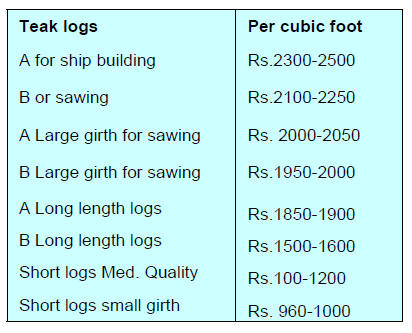
Good quality non-teak hard wood logs, 3 to 4 metres
long
logs having girths 91cms and up of haldu (Adina
cordifolia), laurel (Terminalia tomentosa), kalam
(Mitragyna parviflora) and Pterocarpus marsupium fetched
prices in the range of Rs.600-800 per c.ft and for medium
quality logs from Rs.500-550 per c.ft.
Plantation teak prices
The current pace of deliveries of imported plantation teak
match demand levels in the domestic markets and as such
there have been no reports of price changes.
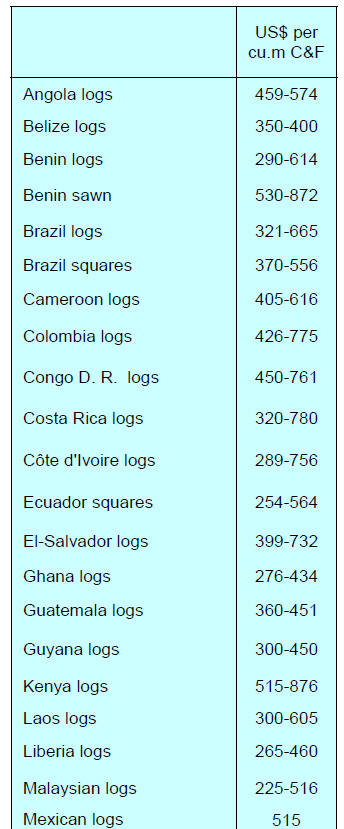
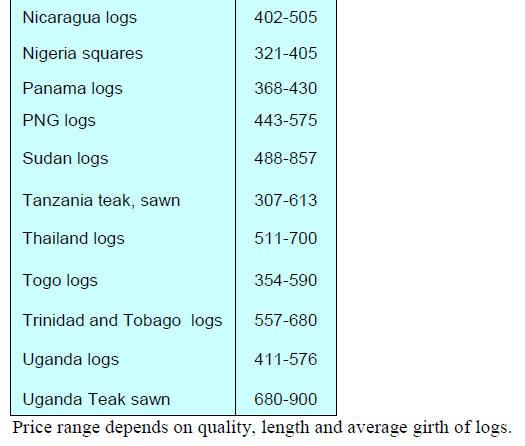
Prices for locally sawn hardwoods
As was the case in July the US dollar/rupee exchange rate
stability has allowed importers to maintain price levels.
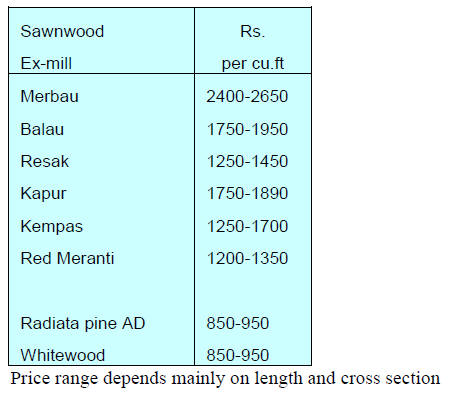
Myanmar teak flitches resawn in India
Ex-mill prices for sawn teak remain unchanged.
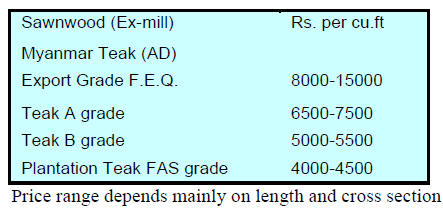
Prices for imported sawnwood
Demand for imported sawnwood is reportedly flat which
is offering no opportunity expanding sales or for price
increases.
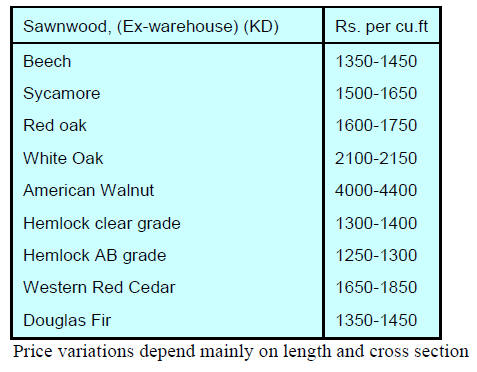
Prices for WBP Marine grade plywood from domestic
mills
Manufacturers report that domestic demand is sluggish
and that prices remain unchanged since last month.
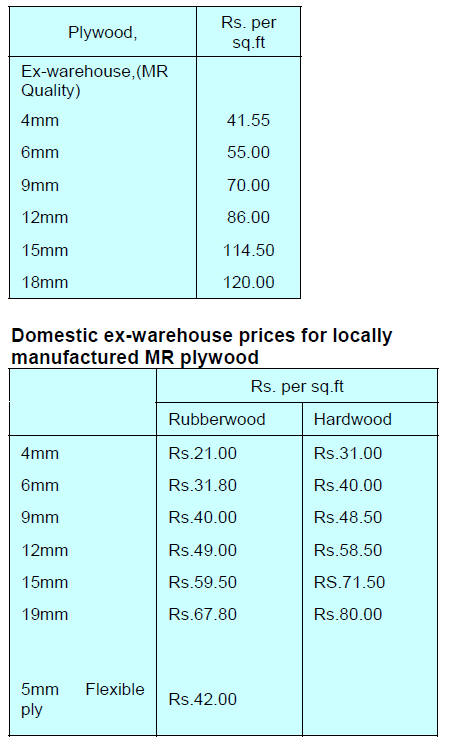
7.
BRAZIL
Wood product trade surplus grows in first
half of 2016
Brazil*s wood product trade surplus totalled US$3.3
billion in the first half of 2016, an increase of 12% over
the same period of last year. Total revenue from exports of
sawnwood, panels, pulp and paper for the first half year
amounted to US$3.8 billion up slightly from the same
period in 2015.
Exports of wood-based panels in the first half were
443,000 cu.m, compared to 289,000 cu.m in the same
period in 2015, a 53% increase. Pulp exports grew to 6.4
million tonnes, a 16% increase over the same period in
2015. Paper exports increased just over 7% to top 1.1
milion tonnes between January and June 2016.
Exports of Brazilian pulp continue to grow, especially to
China, which was the main market in the first half of 2016.
A noticeable trend has been the effort of the pulp, paper
and wood based panel industries to focus on exports as the
strategy to partially offset the decline in domestic demand.
Domestic sales of wood-based panels totalled 3.2 million
cu.m in the first half, down 4.2% compared to the same
period last year. Domestic sales of paper totalled 2.6
million tonnes, being at about the same level as in the first
half of 2015.
July export performance
In July 2016, Brazilian exports of wood-based products
(except pulp and paper) fell marginally compared to levels
in July 2015, from US$237.4 million to US$ 237.0
million.
On the other hand, the value of pine sawnwood exports
increased 0.7% year on year from US$27.6 million in
2015 to US$27.8 million in the first half of this year. In
terms of volume, exports of pine sawnwood increased
18.5% over the same period, from 124,000 cu.m to 47,000
cu.m.
Similarly, tropical sawnwood exports increased 19.6% in
volume, from 27,100 cu.m in July 2015 to 32,400 cu.m in
July this year and but the value of exports rose just 9%
from US$13.6 million to US$14.8 million, over the same
period.
Brazil*s pine plywood exports declined in July 2016 (-1%)
in comparison with exports in July 2015, from US$34.2
million to US$33.9 million but the volumes shipped
jumped almost 27% from 102,900 cu.m to 130,300 cu.m,
during the same period.
As for tropical plywood, July 2016 exports increased 31%
in volume (from 9,700 cu.m to 12,700 cu.m) and export
revenues increased around 9% from US$4.6 million to
US$5.0 milion.
It came as a disappointment that July 2016 exports of
wooden furniture fell around 6.5% year on year.
Best practices in Brazilian plantation sector explained
The Brazilian Tree Industry (IBA) explained its &best
practices* used in the Brazilian plantation sector during the
23rd session of the FAO Committee on Forestry (COFO).
IBA explained that plantations are being established in
&mosaic* form interspersed between the natural forest so as
to create ecological corridors. IBA reported that the
adoption of innovative landscape management results in
multiple benefits in terms of biodiversity sustainability,
regulation of water resources and conservation of natural
forests.
IBA also highlighted that for each hectare of industrial tree
plantation around 0.7 hectare of natural forests was set
aside for conservation.
Satelite images and algorithms to detect deforestation
According to data from a Deforestation Alert System
(SAD) in June 2016 deforestation over the entire Amazon
exceeded 970 sq. km, a massive increase compared to the
same period in 2015. SAD projections are based on
analysis of satellite pictures and the use of algorithms to
estimate changes in forest cover, The states that the system
identified as most affected were Par芍, Amazonas and Mato
Grosso.
For more see: http://www.vizzuality.com/projects/imazon
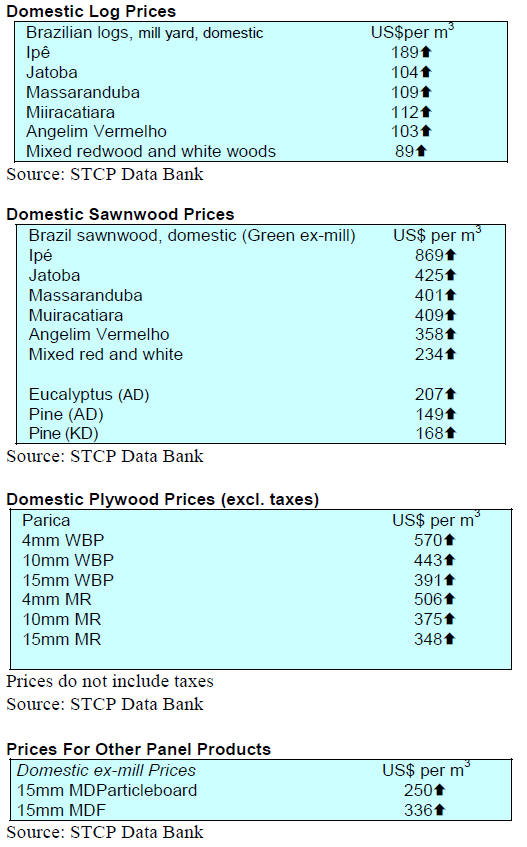
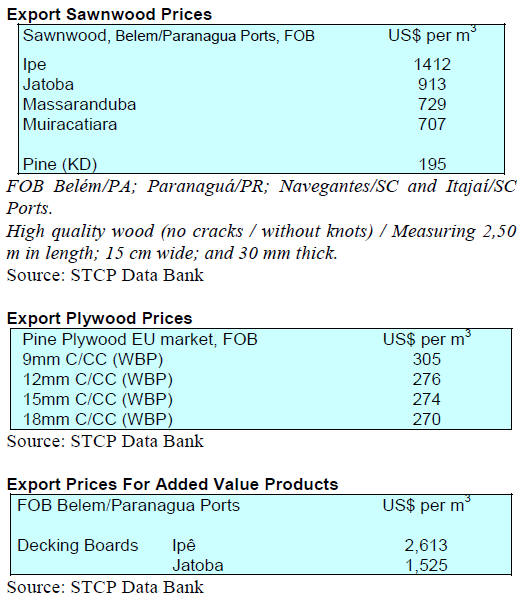
8. PERU
ADEX calls for harnessing wood processing
sector to
spur economy
The timber sector is a vital part of the Peruvian economy
and the Association of Exporters (ADEX) has called on
the government to create the right conditions for increased
investment in the sector to reverse the decline in exports.
In the first half of this year wood product exports were
valued at US$62.3 million an almost 22% decline year on
year.
Exports of semi-manufactured products (US$35.6 million)
fell by 1%, sawnwood exports fell almost 50% in the first
half and veneer and plywood fell by 38% followed by a
drop in furniture exports of 44%.
Manufacturers in Peru are experiencing strong domestic
demand as the construction sector is booming and it is
partly the diversion of output to the domestic market that
has impacted exports.
The chairman of Wood and Wood Industry ADEX, Erik
Fischer, has said the country has a viable wood processing
sector and ample resources that should to be harnessed to
spur economic growth.
APEC discusses how best to combat illegal logging
At the 10th Meeting of the Expert Group of the APEC on
Illegal Logging and Associated Trade (EGILAT) that was
held in Lima from 17 to 18 August the focus was on
strengthening the means through which illegal harvesting
can be eliminated.
Participants were from Australia, Canada, Chile, South
Korea, Philippines, New Zealand, Malaysia, Papua New
Guinea, China, Russia, Taiwan P.o.C and the United
States. During the meeting Peru hosted a workshop with
the theme "Strengthening Forest Control and Marketing
Chains in APEC Economies" This addressed the
importance of traceability mechanisms and how
implementation can be managed as a tool for economic
development of SMEs and communities.
EGILAT aims to strengthen political dialogue and is
carried out within the framework of the preparatory
meetings of the Asia-Pacific Economic Cooperation
(APEC).
